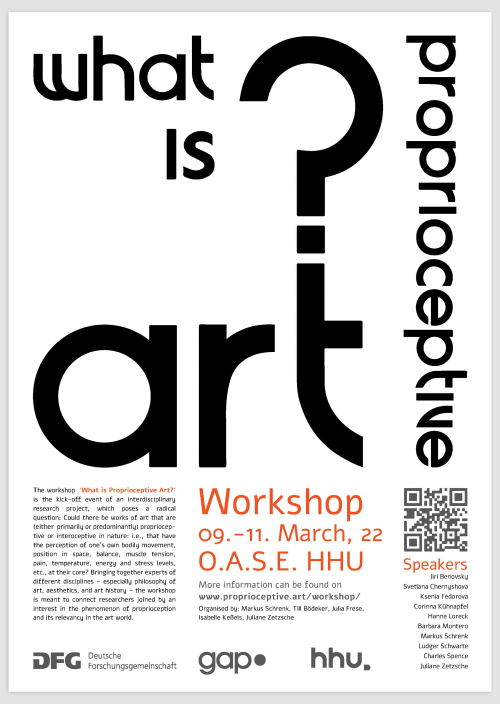Many works of art are predominantly visual or auditory in nature (visual arts such as drawing, painting, photography or performing arts like music). Only some art works (happenings, fluxus, performance) might also crucially involve the audience’s own physicality and thereby intentionally provoke the recipients’ perception of their own body, i.e. their proprioceptions.
Could there be works of art that are either primarily or predominantly proprioceptive in nature: i.e., that have the perception of one’s own bodily movement, position in space, balance, muscle tension, pain, temperature, energy and stress levels, etc., at their core: Is proprioceptive art possible?

Is Proprioceptive Art Possible?
A Research Project
[Please note that this text’s aim is to help the project getting started, to gather ideas. This fairly preliminary work is by no means the project’s end product!]
Many works of art are predominantly visual or auditory in nature (e.g. drawing, painting, photography or music). Mixed forms are also common (e.g. opera, theatre, dance). The so-called chemical senses (smelling/tasting) are hardly ever addressed and only some works of art (happenings, fluxus, certain performances) involve the audience’s own physicality and might thereby also – together with vision and audition – intentionally provoke the recipients’ perception of their own body, i.e., their proprioception.
This project poses the radical question whether there could be artworks that are essentially proprioceptive in nature, i.e. that have the perception of one’s own body’s movement and position in space, balance, muscle tension, stretching, pain, temperature, energy and stress levels, etc., at their core (while paying less attention the other senses). In addition to theoretical considerations which show the plausibility of a positive answer, potential examples for this art form will be given.
The text is organised in six sections. The first, (1), concerns general individuation criteria for sense modalities (seeing, hearing, etc.), the second, (2), specifically addresses proprioception. The third, (3), qualifies proprioception as aesthetic sense. Section (4) characterises proprioceptive art, (A), as a practice the primary or only focus of which is aesthetic proprioception; a practice which, (B), qualifies as art. Now, is such art possible? Core section (5) argues that certain existing aesthetic proprioceptive practices are indeed art. Since factuality entails possibility, the question whether proprioceptive art is possible is thereby answered positively. The final section, (6), looks at open questions and makes some observations.
(1) Different sense modalities (cf. Ritchie & Carruthers 2018: 355) consist of different detector mechanisms that each transduce a range of sensed physical properties into an informational signal to the central nervous system. These mechanisms have evolved to represent these properties and the signals are utilised by the organism to guide (intentional) action. Sense perceptions might be representations with (nonconceptual) content which have a mind-to-world direction of fit. Some also have a notorious specific phenomenology.
(2) Proprioception, specifically, is the often (but not always) subconscious perception of stimuli within the body: spatial orientation, one’s body’s movements, sense of equilibrium (via gravity and the vestibular system); position of our limbs and one’s posture or muscle tension (via mechanosensory neurons); pain, thermal sensations, or itches (via nociceptors and thermoreceptors); energy and stress levels, heartbeat, shortness of breath, etc. (via visceroception).

Often the terms „interoception“ or „kinaesthesia“ are used for proprioception and sometimes just a subset of the above is labelled „proprioception“. I take the term to mean all of these sensations/perceptions. A common factor is the detection of one’s body’s internal states, not the detection of features of the body-external world.
(3) Barbara Montero (2006) has argued that proprioception can be an aesthetic sense:
„One can make aesthetic judgments based on proprioceptive experience. One way professional dancers claim to evaluate the aesthetic qualities of their movements is by feeling (that is, proprioceiving) what is right. The dancer can feel that this particular way of movement is better than the other way: it is more exciting, or graceful, or brilliant, or any other number of aesthetic qualities that bodily movements can manifest.“
Montero 2006; also compare to the works of Richard Shusterman, for example Shusterman 2008 or 2012: esp. item 5; and, importantly, chapters 2.3-2.5 in Benovsky’s 2020: 10-25); cf. Schrenk 2014: 108, 111
(4) Now, a proprioceptive artwork would be, (A), a practice the primary or only focus of which is aesthetic proprioception. This practice has, (B), to qualify as work of art. ‚Primary or only‘ is added because, since we are embodied creatures, just about any practice (e.g. looking at paintings in a museum) involves our bodies and, thus, this practice will inevitably be accompanied by proprioceptions. Yet, these are not the primary or only focus of that practice. (Note aside that dance might qualify but is predominately considered a visual art.) Consider yoga or certain forms of meditation practices, martial arts or climbing (cf. Conroy 2015; Nguyen 2018): here, often, the primary or only target is proprioception.
Regarding (B), note that it is notoriously difficult to define ‚art‘. The next section is dedicated to handle this obstacle.
(5) Institutionalism is the theory of art which says that objects, performances, practices, etc. qualify as works of art if they are sanctioned by art schools, museums, galleries, etc.:
„A work of art […] is (1) an artifact [performance, practice, …] (2) upon which some society or some sub-group of a society has conferred the status of candidate for appreciation“
Dickie 1969: 254; my addendum
For Institutionalism, art is a convention-bound social practice. Danto’s concept of the ‚art world‘ and the respective sub-group of a society who are knowledgeable about artistic theory, art history, etc., is an integral part of Dickie’s idea (cf. Danto 1964).
Now, examples will be given for which holds that, (A), they are a practices the primary or only focus of which is (aesthetic) proprioception, plus: the art world „has conferred the status of candidate for appreciation“. Thus, they, (B), qualify – by the lights of Institutionalism – as works of art.
(Caveat: Surely, Institutionalism is but one theory to demarcate art from the non-art, and can, therefore, just serve as an example. Yet, we think that no matter what theory of art one holds (Levinson’s Historical Definition (1979) or Weitz’s family resemblance claims (1956)) we believe we can give good reasons, also within the framework of those theories, why various body practices are proprioceptive art.)

To mention but a few works of art that are, by the lights of Institutionalism, art: Carsten Höller’s Test Site (2006) a giant slide in London’s Tate Moderns on which the artist himself remarks:
„The state of mind that you enter when sliding, of simultaneous delight, madness and ‘voluptuous panic’, can’t simply disappear without trace afterwards. In this sense the ‘test site’ isn’t just in the Turbine Hall, but is also, […] in the slider […] who’s stimulated by the slides: a site within.”
Höller 2006; my italics
An essential part of Höllers artwork is that the participating audience’s sense of equilibrium, spatial orientation or gravity is disturbed, muscle tensions and the raise of stress levels and heartbeat rate are experienced. Consider also ‚Welt ohne Außen‘ at Gropius Bau Berlin, an exhibition by curators Thomas Oberender and Tino Sehgal whose self-ascribed primary or only focus was „embodied aesthetics“, „bodily practices“, „full-bodied engagement and practice“ (Website Berliner Festspiele 2018). Proprioceptive art can, of course, be found much earlier in the Body Art of the 60s and 70s: Take, for example, Bruce Nauman’s corridor sculptures which trigger an increased (claustrophobic) self-perception and challenge the physical and physiological reactions of the recipients. Most notable is also Naumann’s 1974 work Body Pressure.
See our work in progress examples page here.
(6) In proprioceptive art, one’s own body becomes an instrument for an unmediated perceptive output and input. This transcends the subject-object divide of the art work and its audience: The performer of proprioceptive art is (necessarily) his or her exclusive audience.
Proprioceptive artworks enable us to feel our bodies aesthetically from within, joined with a positive affirmation of being embodied creatures.




